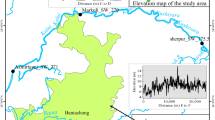Abstract
The occurrence of natural phenomena such as floods has caused serious consequences for human societies. The simulation of flood hazard maps and its depth in a river is one of the most complex processes in hydrology. In fact both geomorphological and hydraulic procedures for deriving the flood hazard maps and depth are imperfect at watershed scale. In this study, a combination of both procedures, using a probabilistic approach is used. Flood inundation maps for 2-, 10-, 25-,50- and 100-return period floods using flood routine within HEC-RAS in combination of Arc-GIS and topographic wetness index (TWI) map were produced. TWI threshold was identified using a maximum likelihood method in order to produce flood prone areas and calibrated over the reach of Zirab City. The correlation between TWI threshold and the flood depth was carried out and simple linear regression developed for various return periods. The resulting regression model is used in order to create flood hazard maps with various return periods at watershed scale.












Similar content being viewed by others
References
Aldridge BN, Garrett JM (1973) Roughness coefficients for stream channels in Arizona. US Geological Survey
Bertolo P, Wieczorek G (2005) Calibration of numerical models for small debris flows in Yosemite Valley, California, USA. Nat Hazards Earth Syst Sci 5:993–1001
Cowan WL (1956) Estimating hydraulic roughness coefficients. Agric Eng 37:473–475
De Risi R, Jalayer F, De Paola F (2015) Meso-scale hazard zoning of potentially flood prone areas. J Hydrol 527:316–325
Degiorgis M, Gnecco G, Gorni S, Roth G, Sanguineti M, Taramasso AC (2012) Classifiers for the detection of flood-prone areas using remote sensed elevation data. J Hydrol 470:302–315
Degiorgis M, Gnecco G, Gorni S, Roth G, Sanguineti M, Taramasso AC (2013) Flood hazard assessment via threshold binary classifiers: case study of the Tanaro river basin. Irrig Drain 62:1–10
Horritt M, Bates P (2002) Evaluation of 1D and 2D numerical models for predicting river flood inundation. J Hydrol 268:87–99
Hunter NM, Bates PD, Horritt MS, Wilson MD (2007) Simple spatially-distributed models for predicting flood inundation: a review. Geomorphology 90:208–225
Jalayer F et al (2014) Probabilistic GIS-based method for delineation of urban flooding risk hotspots. Nat Hazards 73:975–1001
Kirkby MJ (1975) Hydrograph modelling strategies. Department of Geography, University of Leeds
Levy JK (2005) Multiple criteria decision making and decision support systems for flood risk management. Stoch Environ Res Risk Assess 19:438–447
Li G-F, Xiang X-Y, Tong Y-Y, Wang H-M (2013) Impact assessment of urbanization on flood risk in the Yangtze River Delta. Stoch Environ Res Risk Assess 27:1683–1693
Li M, Wu W, Wang J, Che Z, Xie Y (2016) Simulating and mapping the risk of surge floods in multiple typhoon scenarios: a case study of Yuhuan County, Zhejiang Province, China. Stoch Environ Res Risk Assess. doi:10.1007/s00477-016-1238-2
Manfreda S, Di Leo M, Sole A (2011) Detection of flood-prone areas using digital elevation models. J Hydrol Eng 16:781–790
Manfreda S, Nardi F, Samela C, Grimaldi S, Taramasso AC, Roth G, Sole A (2014) Investigation on the use of geomorphic approaches for the delineation of flood prone areas. J Hydrol 517:863–876
Nardi F, Vivoni ER, Grimaldi S (2006) Investigating a floodplain scaling relation using a hydrogeomorphic delineation method. Water Resour Res 42:W09409
Nardi F, Biscarini C, Di Francesco S, Manciola P, Ubertini L (2013) Comparing a Large-Scale DEM-Based Floodplain Delineation Algorithm with Standard Flood Maps: the Tiber River Basin Case Study. Irrig Drain 62:11–19
O’brien J, Julien P, Fullerton W (1993) Two-dimensional water flood and mudflow simulation. J Hydraul Eng 119:244–261
Pappenberger F, Beven K, Horritt M, Blazkova S (2005) Uncertainty in the calibration of effective roughness parameters in HEC-RAS using inundation and downstream level observations. J Hydrol 302:46–69
Patro S, Chatterjee C, Mohanty S, Singh R, Raghuwanshi N (2009) Flood inundation modeling using MIKE FLOOD and remote sensing data. J Indian Soc Remote Sens 37:107–118
Rahman MM, Arya D, Goel N, Dhamy AP (2010) Design flow and stage computations in the Teesta River, Bangladesh, using frequency analysis and MIKE 11 modeling. J Hydrol Eng 16:176–186
Swets JA (1988) Measuring the accuracy of diagnostic systems. Science 240:1285–1293
Tate EC, Maidment DR (1999) Floodplain mapping using HEC-RAS and ArcView GIS. University of Texas at Austin, Austin
Tehrany MS, Pradhan B, Jebur MN (2015) Flood susceptibility analysis and its verification using a novel ensemble support vector machine and frequency ratio method. Stoch Environ Res Risk Assess 29:1149–1165. doi:10.1007/s00477-015-1021-9
Townsend PA, Walsh SJ (1998) Modeling floodplain inundation using an integrated GIS with radar and optical remote sensing. Geomorphology 21:295–312
Yang J, Townsend RD, Daneshfar B (2006) Applying the HEC-RAS model and GIS techniques in river network floodplain delineation. Can J Civ Eng 33:19–28
Zou Q, Zhou J, Zhou C, Song L, Guo J (2013) Comprehensive flood risk assessment based on set pair analysis-variable fuzzy sets model and fuzzy AHP. Stoch Environ Res Risk Assess 27:525–546
Acknowledgments
The authors would like to thank the Zirab municipality for providing the DEM of Zirab reach. Finally, the authors would like to appreciate unknown reviewers for their useful reviews and comments on this work.
Author information
Authors and Affiliations
Corresponding author
Rights and permissions
About this article
Cite this article
Motevalli, A., Vafakhah, M. Flood hazard mapping using synthesis hydraulic and geomorphic properties at watershed scale. Stoch Environ Res Risk Assess 30, 1889–1900 (2016). https://doi.org/10.1007/s00477-016-1305-8
Published:
Issue Date:
DOI: https://doi.org/10.1007/s00477-016-1305-8




